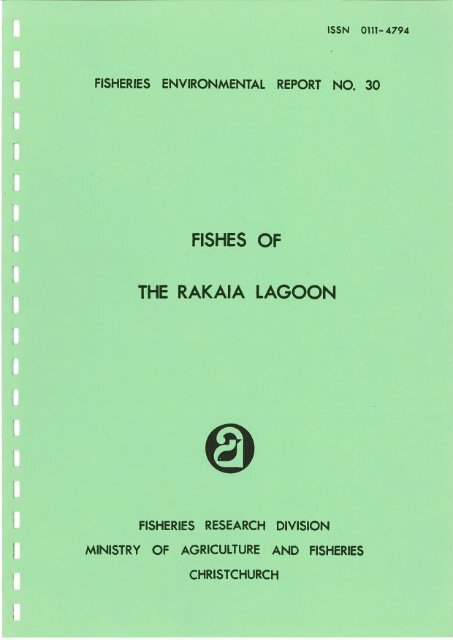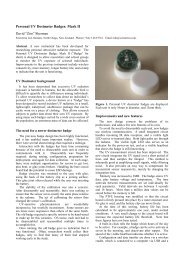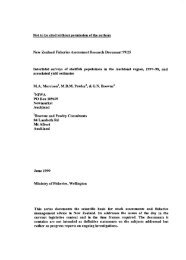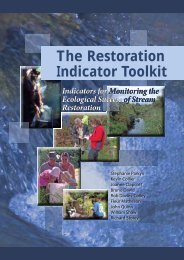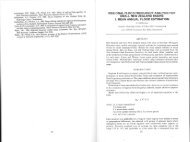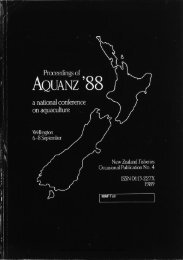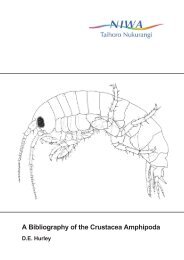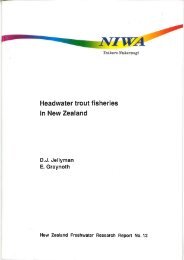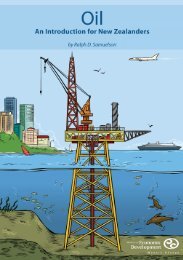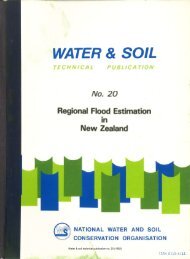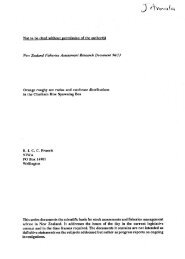THE RAKAIA LAGOON
THE RAKAIA LAGOON
THE RAKAIA LAGOON
- No tags were found...
You also want an ePaper? Increase the reach of your titles
YUMPU automatically turns print PDFs into web optimized ePapers that Google loves.
ssN oilt- 4794FISHERIES ENVIRONMENTAL REPORT NO. 30FISHES OF<strong>THE</strong> <strong>RAKAIA</strong> <strong>LAGOON</strong>FISHERIES RESEARCH DIVISIONMINISTRY OF AGRICULTURE AND FISHERIESCHRISTCHURCH
FISHES OF<strong>THE</strong> <strong>RAKAIA</strong> <strong>LAGOON</strong>BYG.A. ELDONA.J. GREAGERFISHERIES ENVIRONMENTAL REPORT NO. 30N.Z. MINISTRY OF AGRICULTURE AND FISHERIESCHRI STCHURCHFEBRUARY19e3
FISHERIES ENVIRONMENTAL RTPORTSEdi ted by: S. F. Dav'i sThis report is one of a series of reports issued by Fisheries ResearchDivision on important issues related to environmental matters. Theyare issued under the following criteria:(1) They are informal and should not be cited without the author'spermission.(2) They are for limited circulation so that persons and organisationsnormally receiving Fisheries Research Division publications shouldnot expect to receive copies automatically.(3) Copies will be issued initially to organisations to which thereport is directly relevant.(4) copies will be issued to other appropriate organisations onrequest to Fisheries Research Division, Ministry of Agricultureand ¡'isheries, Private Bag, Christchurch.(5) These reports will be issued where a substantial report is requiredwith a time constraintr e.9. a submission for a tribunal hearing.(6) They will also be issued as interim reports of on-going environmentalstudies for which year by year or intermittent reportingis advantageous. These interim reports will not preclude formalscientific publi-cation.
CONTENTSPage1.I ntroducti on12.Study Area13.Materi a I s54.l4ethods85.The Fishes5.1 Quinnat salmon5.2 Brown trout5.3 Rainbow trout5.4 Perch5.5 Stokell's smelt5.6 Common smel t5.7 Inanga5 .8 Common bu1 'ly5.9 Bluegilied bulìy5.10 Giant bu'lìy5. 11 Up'l and buì ìy5.12 Torrentfish5. 13 Bl ack fl ounder13152730303133343737374040405.14 Longfi nned eel and5.15 Lamprey5. 16 Yel'loweyed mul I et5.L7 Kahawai5. 18 Koaroshortfinned eel42454747506.Food of fishes507.Di scuss i on53
iìPage8.Concl usions599.Acknowl edgements6110.Literature Cited61TABLES1. Sampling sites netted in the Rakaia Lagoon duringJu'ly 1980- July 1981.2. Fish specjes recorded from Rakaia Lagoon, compared wjthspecies lists from Lake Ellesmere, Avon-HeathcoteEstuary and Ahuriri Estuary.3. Numbers of each species of fish caught durjng eachsampf ing period in the Rakaja Lagoon, July 1980-July 1981.4. Numbers of each species of fish caught at each sampfings'ite in the Rakaia Lagoon, July 1980-Ju1y 1981.5. Water turbidity at netting sites in the Rakaia Lagoonduri ng Ju'ly 1980-Ju 1y 1981 .6. Salmon releases into the Rakaia River and lagoon catchesof juvenjle salmon during January-July 1981.7. Tagged quinnat salmon recaptured in Rakaia Lagoon,February-July 1981.1618202724258.o10.11.Recaptures of trout tagged in the Rakaia Lagoon duringAugust 1980-Juìy 1981.Sex ratio of sub-samples of Stokell's smelt taken fromRakaia Lagoon, October 1980-April 1981.Recaptures of eels tagged in the Rakaia Lagoon duringAugust 1980-Juìy 1981.Diet of nine species of fish from the Rakaia Lagoon,July 1980-July 1981.29334451Distribution of qu'innat salmon in sejne net catches,the mean catch per set, July-December 1980, prior tolagoon release of tagged fish.12. and55the
iiiFIGURESPage1. Rakaia Lagoon, showing sampling s'ites and location ofriver mouth in July 1981.32. Collecting fish from a beach seine haul on the seaward 6shore of the Rakaia Lagoon.3. Hauling the beach seine on to the seaward shore of theRakaia Lagoon. The inland shore can be seen in thebackground.4. Setting the beach seine net from the bow of a'Funfisher' 11di nghy.5. Collecting a fyke net from the North Branch.6. Mean temperatures recorded fortnightly at seine netsampf ing s'ites in Rakaia Lagoon, August 1980-July 198i.7. Length frequency of quinnat salmon sampled from theRakaia Lagoon, Ju'ly 1980-July 1981.t2L4228. Length frequency of quinnat salmon captured by inclined 26plane traps located in the lower 6 km of the Rakaia Rivermainstem during 1980.9. Length frequency of brown trout sampled from the Rakaia 28Lagoon, July 1980-July 1981.10. Length frequency (a) and mean lengths (b) of sub-samples 32of Stokell's smelt taken from Rakaia Lagoon, October 1980-April 1981.11. Length frequency of common smelt samp'led from the Rakaia 35Lagoon, August 1980-July 1981.12. Length frequency of inanga (excluding whitebajt) sampled 36from Rakaia Lagoon, August 1980-July 1981.13. Length frequency of common bullies sampìed from Rakaia 38Lagoon, August 1980-July 1981.14. Length frequency of preserved bluegilled bul'lies sampled 39from Rakaia Lagoon on 28 Apri'l 1981.
'tv15.Length frequency of preserved torrentfish iuvenílessampìed from Rakaia Lagoon, Ju'ly 1980-July 1981.16.Length frequency of black flounders sampled fromRakaia Lagoon, July 1980-July 1981..4849
1. INTRODUCTIONThis study was part of Fisheries Research Division's (FRD) programmeto investigate the fisherjes values of the lower Rakaia R'iver in the face ofurgent demands for irrigation water (Davis 1979), and to provide fisheriesinformation to the North Canterbury Catchment Board to assist in the'ir reviewof the Rakaia River water allocation p'lan (North Canterbury Catchment Board1974). Further reports detaiìing results from other aspects of FRD's programmeare currently in preparation.Field work for this study took place between July 1980 and Juìy 1981,except that some invertebrate work was somewhat later in starting and finish'ing.The aims of the study were to learn which species of fish utilised the Rakaia Lagoon,seasonal differences in the relative abundance of each species, and the extentof the lagoon's importance to fisheries genera'lly, particularly as a rearingarea for juvenile salmon. There are no published data on sim'ilar environmentsto the Rakaia Lagoon in New Zealand. Although fish populations of the nearbyAvon-Heathcote Estuary were studied by Webb (tglZ, 1973a, b, c, d), and K'ilnerand Akroycl (1978) investigated the fish and invertebrate fauna of the AhuririEstuary'in the North Island, the Raka'ia Lagoon is unlike these estuaries inthat there is no ebb and flow of the tide (see Section 2, descript'ion ofstudy area). Data from this study therefore provide new informat'ion on theseasonal changes in specìes composit'ion and relative abundance of fishpopulations at the mouth of a large South Island east coast bra'ided river.2. STUDY AREABarnes (1980) descrjbed a coastal lagoon as an area of salt or brackishwater, separated from the adjacent sea by a ìow-'lying sand or shingìe barrier,and having a small mouth with ljttle exchange or throughput of water, whileestuaries were described as having relatively wide mouths and a 'large exchangeor throughout-put of water in relation to their volume. By these criteria
2.the Rakaia study area was an estuary, since the water was fresh and there wasa large through-put from a big river. However, there was no ebb and flow ofthe tide (although there was a tidal back-up of fresh water), and there werefew, if any, predominantly estuarine ljfe-forms. Local usage termed the areaa lagoon and this word has been used here for lack of a better one.The Rakaia Lagoon (fig. 1) encompassed that stretch of water where theriver, on reaching the coast, was deflected to run parallel to the shore for avariable distance before breaching its 20-150 m wìde gravel bar. The lagooncomprised two distinct areas:(i )South-west of the mouth, wherever it occured at any time (Fi9. 1), thewater flowed at a greater or lesser vélocity according to the state ofthe tide, the power of the ocean waves and the discharge of the RakaiaRiver. There was never a reverse water flow, although occasionallyrollers penetrated the mouth or spilled over the bar. Fresh waterbacked up for a variable distance at high tide, but frequent'ly thesingìe broad channel at this point was all that distinguished the lagoonfrom the braided river upstream.(ij) North-east of the mouth there was a ponding area of relatìvely slackwater (Fig. 1), the level of which varied with the conditions listedabove. There was a reverse flow of water here on flood tjdes, as thebanked-up river flowed in, but the water was fresh, apart from rare'influxes of sea water when roliers topped the bar.The most strjking feature of the whole lagoon was its changeability. Theriver mouth could occur at any poínt a'long a 4-5 km front, and at rare intervalsthere were two mouths. The movement of the mouth usually follov¿s a pattern:a high f'lood breaches the bar opposite the mainstem of the rìver, allow'ingegress straight out to sea; prevai'ling winds and ocean currents deflect themouth to the northeast, forming a channe'l of variabìe length (typicalìy200-300 m) through the shingle bar; over succeeding months, the mouth "creeps"
FiGURE 1.Raka'ia Lagcon, showing sanrplinq sites and location of the rivershotv where sites were moved due to changed river conditions.)P = plankton transect; E = epìbenth.ic transect.mouth in July 1981.S = seine net; F =(spt i tfyke net;indi cator I ines6 = gi11 net;OJ
5.access to the sea via culverts. As a result, the sea has encroached onthis end of the lagoon because there'is now no current to keep'it open.Several pools isolated from the lagoon by shingle fans thrown over by the seaare evidence that the ìagoon is contracting. Local residents also claimedthat the north-eastern end of the'lagoon has narrowed to about half its formerwi dth.The seaward shore of the lagoon comprised a bar of loose shing'le ofvarying slope (fig. 2). Where the current was swift, the bank was steep andoffered no footing. At other pìaces good beach sein'ing sites v¡ere present.Bays formed by the closure of former mouths were easi'ly sampled when new, butgradually filled with glac'ial silt and became unworkable. The inland shoreof the lagoon comprised a m'ixture of debrjs-strewn gravel and mud beaches,and rush or grass covered mud steps (fig.3). The various braids of theRakaia R'iver entered at ìntervals and sometimes provided workable beach seinesites.Mathias Creek, Boat Creek and the North Branch (Fjg. 1) are small,spring-fed tributary streams, though the North Branch carries mainstemflood water at times and provides a passage for mìgrant iuvenile salmon.There is another tributary stream at the south-western end of the'lagoon whichis not shown in Figure 1.During the study period, macrophytes (ugriophgJJum Spp. , Efodea canad.ensis,potamogeton cheesemanii, etc.) grew only in tributary streams and in the northeasternend of the lagoon over a distance of about 800 m. In summer, growthof macrophytes and algae (rit"Jra, Enteromorpha spp.) was so prolific thatfish sampling was seriously hampered in the north-eastern end of the'lagoon.3. MATERIALSA 3.85 mfibreglass "Funfisher"dinghy powered bya 15 h.p. Johnsonoutboard motorprovided an excellent,stable work boat,but the motor was
6.FIGURE 2.Collecting fish from a beach seine haul on the seaward shoreof the Rakaia Lagoon.
7.FIGURE 3.Hauling the beach seineThe inland shore can beontoseenthe seaward shore of the Rakaia Lagoon.in the background.
8.inadequate for the loads involved. Hazardous navjgation conditions resulted'in continual damage to the propeller. However, a iet boat would have beenno advantage at the s'low operating speeds required, and would have beenunmanageable for net setting.A beach seine net, 30 x 3 m with 13 mm stretch mesh, fitted wìth two 10 mlong bridles and 24 nlong hau'ling ropes, was the principal sampling equipmentused. A subsjdiary net, 20 x 1.5 m, of the same material but with a 10 ml'ining panel of mosquito netting, was used jn confined or shallow areas. A40 x 3 m nylon monofilament gi'|l net comprising 10 m each of 85 mm and 56 mmmesh, and 20 m of 38 mm meshrwas used regularly, while a 30 x 2 m ny'lonmonofilament gil'l net with 15 mm mesh was used at two seine sites on twooccasions when weed growth prevented seining. Single-ended commercial-typefyke nets and a mini fyke of 15 mm mesh were used to sample fish moving at night.Plankton sampìes were taken using twin nets of 203 micron mesh, with 29.5 mm d'iameteropenings, mounted each side of the boat (Tarplee, Bryson and Sherfjnskj 1979).A diver-operated s'led (Sibert, Kask and Brown 1977) with a 10 cm squareopen'ing fitted with a 530 micron mesh net, was used to sample the epibenthos.The sled was pushed a'long a 50 m transect and separate samples collectedfrom each 10 m section.4. METHODSllett'ing took p'lace over three days and two nights fortnightly from Ju'ly1980 to July 1981 - 27 samplìno periods in all. Invertebrate samp'les weretaken fortnightìy from September 1980 to September 1981.Beach se'ining v,,as carried out by day at as many of L3 reguìar sites asposs'ible (Fig. 1). These s'ites were selected on the basis of the ava'ilabilityof a beach, workabl e fl ow and freedom from snags. Many factors, such asmovement of the mouth, presence of recreat'ional flounder nets, etc. couldrender a site 'inoperab'le for one or several sampl'ing perìods. Conversely, it
9.TABLE 1. Sampììng sites netted jn the Rakaia Lagoon during Ju'ly 1980-Ju'ly 1981(see Fig. 1 for location of each site).Sampl ePeri odSeine Net Sites Fyke Net S'ites Gill Sitesr23456789101112L3* r234567* 1*22-23. 7 .805-7.8.8020-22.8.802-4.9 .8016-18.9.8030.9-2. 10 .8074-L6.10.8028-30.10.8011-13.11.8025-27. 11.809-11. 12.80?r-22. 12.806-8. 1. 812L-23. 1.813-5. 2.81t7 -I9.2.8t3-5.3.8117 -L9. 3 .8 13t.3-2.4.81t4-t6. 4. I 128-30.4.8112-14.5.8r26-28. 5 .8 I9-11.6.8123-25. 6 .8 17 -9 .7 .Br2t-23.7 .8LI+ -+I++ +-f+++ +-++f+--++-+fI++a+ -++ +++++ ++IIf++--+--++ + + +o- - - -++++++-+++++++--++++-+--++++++-++++++++-+++++++-+++++++-+ + +o+ - + - ++++++++-+++++++-+-+++++-++++++--+++++++-+++++++-++++-++-+++++++-++++++-++++++++-+++++++-+ + +o+o+ + + -+++++++-+ +o+ + + + + -+++++++-+ = Net set- = No net set* = Net set at imegu'lar sites on an opportunistic basisf= Effectiveness of fyke net doubtful
10.was occasionally possible to seine a locality not normally available (Table 1).It was not practical to sample sites ín a given order or at a partìcular stageof the tide, and work was carried out as conditions permitted. Usually thenet was set from a drum over the bow as the boat was manoeuvred in reverse(Fig. 4).Ideally, sets were made paraì1eì to the beach at the extremity of theropes and bridal (i.e. 34 m from the shore) and the net hauled onto thebeach (Fig. 3). However, many variatjons of this techn'ique were requìred tocope w'ith currents and snags. Fish captured in seine nets were normallyundamaged.Gillnettjng was carried out regularly at n'ight only, at one site (Fig. 1).Occasionalìy, extra sets were made elsewhere in the lagoon for various purposes,e.g. day-time sets were tried but were invariabìy unproductive. Mullet takenìn the gill net were aìways dead on retrievaì, and other species also sufferedh'i gh mortal 'ity.Fyke nets (Fig. 5) were set overnight at seven regu'lar and some occasionalsites (Fig. 1). Times of setting and lifting'varied, but each net fishedthrough one night high tide. Due to large variations in water level from dayto day, netting efficiency could not be controlled or monitored. Fish takenin fyke nets were usually alive, but delicate specìes such as smelt were ofteni nj ured .A p'lankton sampìe was taken fortnightly from September 1980 to September1981 at high tide, river conditions permitting, at each of three transects(Fig. 1). Consistency in the volume of water sampled was obtajned by counting200 revolutions of a boat-mounted current meter. Thus, water volume, stateof the tide and sampling station were constant at each sampling. Sample depthwas constant relative to the boat, but varied with water levels in the lagoon.0n compietion of each tow, the nets were washed and the contents preserved in B%formal i n.
11.FIGURE 4.Setting the beach sejne net from the bow of a 'Funfisher'dinghy.
12.FIGURE 5.Collecting a fyke net from the NorthBranch.
13.An epibenthìc sampìe was collected fortnightly from December 1980 toAugust 1981 at high tide, river conditions permitting, at each of two 50 mtransects. Each transect was d'ivided into fjve 10 m lengths. Sampìes werepreserved tn 8% forma'lin. Results of the invertebrate survey wiì1 bereported jn detail elsewhere.All fish were measured, except where numbers were so great that sub-sampìingwas appropriate" Live fish were anaesthetjsed w'ith benzocaine before beìnghandled, and were released later unless required for stomach analysis orconfirmation of species (i.e. smelts). Trout were also weighed and sampledfor scales, and healthy trout and eels were tagged with 'F'loy' streamer-typetags. Tagging was done primarily to learn something of the movement of thesefish within the Rakaia River.Two methods were used to assess fish stomach contents in the laboratory -volumetric (percent composìtion) and percent occurrence. The volume of eachstomach examined was assessed for fullness using the poìnts method of Eldon(L979) and a scale of 0-40. Each food item was assigned poìnts in relationto the proportion of the total stomach contents'it represented, and thesewere summed and expressed as a percentage fór each food category. Percentoccurrence was the proport'ion of stomachs in which each food category was found.Water temperatures ulere usually recorded at each seine site during nett'ing.Temperatures ranged from a low of 6"C in June 1981 to a high of 21'C inFebruary 1981, but variations of as much as 6oC were noted between sampl'ingsjtes on some days in summer. The temperature at site S1 was more stablethan elsewhere in the ìagoon, genera'lly being higher than other sites in winterand lower in summer. Mean temperatures recorded during each samplingperìod are presented in Figure 6 to show the pattern of annual variation.5. <strong>THE</strong> FISHESFourteen indigenous and four introduced species of fish were recorded
^15 c)oUJÉ.=t--&HtotrJFAUGFIGURE 6.SEPOCTI'lean temperaturesNOV DECrecorded fortnlghtly atJANFEBseine net samplingIfARsites lnAPRMAYRakaia Lagoon, AugustJUNJUL1980 - ,July 1981.lJÞ
15.from the Rakaia Lagoon and a further ind'igenous species, the koaro (GaJ-axiasbrevipinnis), is known to pass through on migration (Table 2). However,four indigenous species - giant bully (coøiomorphus gobioides), upland bully(c. trrevi""p"), lamprey (ceotria austral-is) and kahawai (erripis trutta) -and two introduced spec'ies - rainbow trout (salno sairdnerü) and perch(e"t"u fTuviatiTis) - numbered fewer than six individuals each during the13 months study (Tables 3 and 4), although kahawai were observed in large numbersimmediateìy offshore. Two other species, bluegilled buìly (Gobiomorphushubbsi) and torrentfish (ch"i*urrichthgs fosteri) occurred on'ly as juvenìlespassing through the lagoon on their upstream migration, but the latter spec'ieswas present in the lagoon for several weeks.Species providing recreational fisheries were quinnat salmon (oncorhsnchustshawgtscha), brown trout (sul^o trutta) and, very occasionally, rainbowtrout (s. gairdnerü ), wh'itebait (cataxias macul-atus, ôrìd to a very minorextent G. brevipinnis), black flounder (ahonbosofea retiarìa), yelloweyedmullet (elati"n"tta rorsteri) and longfinned and shortfinned eel s (ansuiJJad.ieffenbachii and e. austraJis). Eels have been exploited commercially inthe lagoon (Davis 1979), but no commercial fishjng took place during thisstudy.Fluctuations in catches between sample periods (Table 3) do not necessari'lyreflect fish abundance. Condit'ions in the lagoon were so variable due tofloods, tides and turbidity (Table 5), that netting effort could not beconstant (Table 1). However, the data jndicate overall seasonal trends.5.1 Quinnat SalmonThis study vvas concerned only with juvenìle salmon, as adults were notsampled by the methods used. The first fry of the 1980 year class were caughtat the end of July 1980 at a time when fingerlings from the previous yearclass (tglg) were still present (FiS. 7). Eight weeks later, the year'lings hadgone and fish of the year were common. Catches declined markedly over theperiod late December to late January, but increased aga'in in February 1981 (Table 3)"
16.TABLE 2.Fish species recorded fromfrom Lake Ellesmere (RyanEstuary (t^lebb 7972, 1,gjSd;(K'il ner and Akroyd 1978) .Rakaia Lagoon, compared with species ljstsI974, FRD unpublished data), Avon-HeathcoteFRD unpublished data) and AhurÍri EstuaryCommonnameSci enti fi cnameRakaiaLagoonLa keEl I esmereAvon-HeathcoteEstuaryAhuri rjEs tua ryQuinnat salmonBrown troutRainbow troutPerchCommon smel tStokel I 's smel tInangaKoaroCommon bu'lìyBlueg'illedbul'lyUpl and bul lyGiant bul lyRedf i nnedÞu'lìyTorrentfi shBlack flounderYellow-belliedfl ounderOncorhgnchus tshawgtschaSal-mo truttaSaLmo gairdneriiPerca ffuviatil_isRetropinna retropinnaStokel-l-ia anisodonGaLaxias macufatusGal-axias brevipinnisGob i omo r phu s c ot i d i anu sGobiomorphus hubbsiGobiomorphus brevicepsGob iomorphus gobioidesGobiomorphus huttoniChe imarrichthg s fosteriRhombosofea retiariaRhonbosol-ea Teporina++OTOT+++OT+OTOTOT++_*OT++++++++OTOTOTOT+OTOT+OT+++++Sand fl ounderGreenbac kfl ounderLongfi nnedeelShortfi nnedeelYel 1 ow-eyedmulletRhombosoLea pTebeÍaRhonbosoJ,ea tapirinaAngu i 77a die f fenbachii4ngui77a austraLis\Tdrichetta forsterilrripis trutta]eotria austral.is+++OTol+OT++++OT+OTOT+++OT+++Teniagnus monopterggiu sOTOTlarassius auratus>eJtorhamphustovaezeel-andiaelripterggion nigri penne'seudoLabrus cef idotus+OT+++OT+OT
17.TABLE 2. (Cont'd)CommonnameSci enti fi cnameRakai aLagoonLa keEl I esmereAvon-HeathcoteEstuaryAhuri riEstuaryClingfishSpratl^lhitingBlue mackerelGarfi s hT rache J-ochjsmus pinnuT atu sMaugaclupea antipodumMerlangius austral-ìsScomber japonicusReporhamphus ihj+OTOTOTOTOTSandfi s hSand eelSunfi s hCrapatalu s novae ze LandiaeGonorgnchus farsteriMol-a mol-a1+OTrecordOTRed codGlobe fishRockfi shMokiThornfi s hBarracoutaKi ngfi shParoreGrey mu'l 1etRed gurnardTreva'l1ySnapperRigPhgsiculus bachusSpheroides richeiAcanthocl-inusquadridactgTusLatridopsis ciLiarisBovichtus variegatusThgrisites atunSerìoLa grandisGirel-fa tricuspidataMugiT cephaTusTrigTa kumuCaranx -Z.uÈescensChrgsophrgs auratusMustelus antarcticusOTOTOT+OTOTOTOTOTOTOTOTOTOT++OTOTSeahorseElephant fishSpiny dogfishSchool sharkBasking sharkSkateGu rnardHippoc ampus abdominaL i sCallorhgnchus mifiiSquaJus acanthiasGal- eorhinu s austraJ,isHalsgdrus maximus maecogiZearaja nasutaCheLidonichthgs kumuOTOTOTOTOTOTOTOTOT+ = resident or regular visitor0T = occasionally present or transìtory- = not recorded-* = recorded since this study
TABLE 3.(Cont'd)Speci esJanuary6-8 2r-23February3-5 17-r9 3-5MarchL7 -T9Apri I3L-2 t4-76 28-30MayL2-I4 26-28June9-11 23-25Juìy7-9 2I-23 TotalQuinnat salmonBrown trout"Rainbow trout"Perc hCommon smel tStokell's smeltInanga#Common bul lyBl uegi'l 1ed bul'lyUpland bul lyGi ant bu1 'lyTorrentfi s hBlack flounderLongfinned eel oShortfinned eel oYel 1 oweyed mul I etKahawa iLampreyStargazer36 2042601191727* 3468* 10013i50000038182759000590tL4000167322822500228420001823I810002377L00006 152409* 944358 22r72 2000000000L7 2T15884 23136 42005500139322205800002511191.24000161300T71017735000023241,658000186007501531B000013799110034L400279I17261891054161039100I41500431111869020B95619222400052002139378008T412I000296102L13136130101916L4110003016001043715I002520I000001620101003118000710I20010903000129L40008136000001 1632792281869336340090819852232577337390949212TOTAL (al Ispecies))-096 4552 602 1106 1469 728 380 391 528 482 L27 27L 166 r24 164 78603o - Includes recaptures of tagged fish# = Excludes fresh-run whitebait* = Estimatesl-¡(o
TABLE 4' Number of each species of fish caught at each sampìing site in the Rakaia Lagoon, July 1980 - July 19g1.Speci esQui nnatsal monBrowntrout"Rai nbowtrout"PerchConunon )smelt and)Stokel I 's )smel t )Inan ga#Conmonbuì ìyBluegilìedbuì lyUp ì andbuì lyGiant bulìyTorrentfi shBi ackfl ounderLongfi nnedeel oShortfi nnedeel oYel I ow-eyedmul I etKahawa iLampreyStargazerS1s2s3s4S5?BB 32 34 96 13623518295100000 0 0 0 '0S6S7s8S97 I45 r24 136123300000000si0sl1s12Sampì ing Sites1346 40 130 4732212000000000therSeineSi tesF1F25402551100000000F3F4F5F6300444000000100 472 169 1310 1390 7006* r17? 41397* 681 10383* 13 260 2103 300ü ? 70 2 61 88 508t60B 619 586 59 0 127 40 133 I29 46 600018000400000010000037407814 4 6129 79 301000002001400t4 32 38 65 14 2r80000000000000000000107 103 2700000000038872r40100001700000000000130000900000010000 0 0 0 95 49 183 0 1 116 O094421403663314861150 0 11BB 0 0 0 0 0 0 000000000010000000010000515200000002I025638280912515290 0 1 0 28 22 4 29 t2 186 500 0 0 0 126 58 30 23 16110 1100048122008526001000000000000000000100020000000F7Other GillFyke Net 0therSites Site1900 I72 1101001100820360000000000000413000000 370 89TOTAL (alìspeci es )2078 1204 988 1870 rTrB 7352 1336 41685 736 104s4 57 416 223s 3318 351 232 283 247 202 r0O3 116 4 501 2r7 78603o - Includes recaptures of tagged*fìshS Seine net s.iteEstimates F = Fyke net s.ite# = Excludes fresh-run whitebait N)O010000000Tota l1 1632792270154340090819852232577337390949I12
2r.TA.BLE 5. Water turbidity at netting sites in the Rakaia Lagoon duringJuly 1980 - July 1981.Samp'lePeri od22-23 Ju1 805-7 Aug 8020-22 Aug 802-4 Sep 8016-18 Sep 8030 Sep-2 Oct 8014-16 Oct 8028-30 Oct 8011-13 Nov 8025-27 Nov B09-11 Dec 802I-22 Dec B06-8 Jan 812I-23 Jan 813-5 Feb 81I7=I9 Feb 813-5 Mar 81I7-I9 Mar 8131 Mar-2 Apr 81L4-16 Apr 8128-30 Apr 81l2-I4 May 8126-28 ttlay 819-11 Jun 8123-25 Jun 817-9 Jul 812I-23 Jul 81Seine Site Localities1.2345678910111213cccCCCMMMCTTCCCCTTcccccTMMCCMTCMMTTTc-MC-MTTcMcTTTCTTMMMMMMCTTcccMMMcccMMMcccCCCCMM-CMMTTTTTTMM-TMT-TMMMMMM-TTT-TMMMMTTTTTCCCCMM-MTT-TMMC-TTTT-TTM-MMM-TT-TCCC-TTMTccc-MMMMCCC-CCccTTTTTTTTMMTMTTTMTTTCMTMMTTTTMMTTTTCCTMCCMMcccTTTTTTMTCMTMTTCCcTTMMMccMc-C-TTTÏ-MMT-T-T-Tc--cMM-T-MTT-Tc-TTCCMMG*cCMMcMCTcMMTMCMTCMcMMMMCcMcG* = Gill net siteC = ClearM = Moderately turb'idT = Turbid- = Not sampl ed
20Aug 198022.020Aug02023900ct 198020c)z.UJ=OtllÉ.L¡-llJC5Fz.t!(-)Étdo-0200200200201.t-27 Nov 198019803- 19 19813-19 Mar020020MarAprAprMay020May020Jun 19810200FIGURE 7.60 70 B0 90 100 110FORK LENGTHLength frequency of quinnat salmonJuly 1980 - July 1981. (Notes:# ='sample periô¿ 'is half as Tõñg;total number in sample.)t20 130 140 150 160 t70 180(mm)samp'led from the Rakaia Lagoon,* = Sample period is twice as long;N = number of fish measured, not
23.There are no data from other studies to suggest a natural increase ofoutmigration in late summer. Hou,ever, in recent years there has beenconsiderable rearing of juvenile salmon - both hatchery produced and artificiaìlyretained wild stock - at Glenariffe and elsewhere on the Rakaia River. 0n tendifferent dates between 2L January and 24 April 1981, a total of 633,407 iuvenilesalmon were liberated jnto the Rakaia River system (Table 6). Almost 21'000 ofthese were released directly into Rakaia Lagoon on 22 January 1981 by the SalmonEnhancement Team of FRD. All these latter fish were adìpose fin-cl'ipped andtagged with coded wire nose tags, but in most other releases a percentage on'lywas tagged and fÍn-clipped (Table 6).Therefore, 'increased catch rates in February 1981 d'irectly followed aliberat'ion of salmon 'into the lagoon, and 83.3% of the sample on 5 February 1981comprised tagged fish (SS of +Z). The seven untagged fish may have been froman upstream liberation made on 2I January 1981, or may have been w'ild stock.All tagged fish retajned from samples taken during 3 February to 27 l4ay1981 were from the single lagoon release on 22 January (faUle 7). The 84untagged salmon caught during that period (Table 6) may have been wild stock ormay have come from the 74.5% of other releases of salmon which were not tagged(Table 6), i.e. excluding the lagoon release on 22 January. From 10 June tothe end of the study, 53 (32.3%) of the 164 juvenile salmon caught were taggedfish. Three of the four tagged fjsh retained had been released at Glenariffe(Table 7).'inofClearly most of our late summer and subsequent catches of iuven'ile salmon1981 were the result of hatchery releases. Not more than 25% (84 of 340)these fish could have been wild stock.Data on downstream migrat'ing salmon collected by three inclined planetraps which operated three days a week between the State Highway 1 bridge andthe lagoon from September 1980 to June 1981 (FRD unpublished data), compìementthe lagoon findings (Fig.8). Salmon catches'in these traps ceased in December
24.TABLE 6. Salmon releases into the Rakaia River and lagoon catches ofiuvenile salmon during January-July 1981.DateNo.rel easedSalmon releasesNo.taggedollotaggedNo.caughtLagoon catchesNo.taggedo/taggedCumul ati vecatch21 Jan111 6804239737 .922 Jan*20 94420944100.05 Feb4235B334219 Feb2I5004420 FebI2T L7T2Lt7t17.55 Mar401845 08411-13 Mar160 72342 50026.419 Mar55100.0B92 Apr16956.3105L2-L4 Apr16 Aprztr 77743 12620.418I50. 0r232I-24 Apr7 TT27 TLz100. 030 Apr34926.5L5714 May14428.617T26 ltlay5240.0t7611 Jun29t758. 620525 Jun2926.92349 Jul16318. 825023 Jul903134.4340TOTALS 633 407 177 250 27.8 340 145 42.7* Rel eased di rect'ly i nto the 1 agoon.
25.TABLE 7. Tagged quinnat salmon recaptured in Raka'ia Lagoon, February -Ju'ly 1981.Date ofrecapture0rì gì nalrel easeI ocati onDate ofrel easeNo. ofdays torecaptureAddi ti onaltagged fishnot keptTotaltagged fishrecaptured3 Feb3 Feb3 Feb3 Feb3 Feb3 Feb3 Feb3 Feb3 FebLagoonLagoonLagoonLagoonLagoonLagoonLagoonLagoonLagoon22 Jan22 Jan22 Jan22 Jan22 Jan22 Jan22 Jan22 Jan22 JanL2t212T2L2T2L2I21226 3518 Feb 1 14 Mar 18 1819 Mar19 Mar19 Mar31 Mar31 Mar14 Apr14 AprLagoonLagoonLagoonLagoonLagoonLagoonLagoon22 Jan22 Jan22 Jan22 Jan?2 Jan22 Jan22 Jan22 Jan56565668682 57 914 AprLagoon8229 Apr 9 982826 9LZ l{ay Lagoon 22 Jan 111 3 427 flay 2 210 Jun10 JunLagoonGl enari ffe22 Jan14 Apr1405715 T723 Jun Gl enari ffe 14 Apr 70 1 28 Jul 3 32t Jul Gl enari ffe 20 Feb 151 30 31TOTAL t23 145
26.6040SeptemberN=4062003040506070BO 90 10060400ctoberN=412200(J30405060708090100=lfJ=qIrJÉ.u-tJJC.DFz.tJJ(-)d.t!ô-604020NovemberN=LB66040DecemberN=33200F0RK LENGTH (mm)FIGURE 8.Length frequency of quinnat salmonplane traps located in the lower 6mainstem during 1980.captured by i ncl 'inedkm of the Rakaia River
27.1980, a'lthough subsequent'ly one fish was caught in March and two in May 1981.This raises the question of the origin of yearlìng saìmon recorded whenthe lagoon project first commenced" 0f 282 yearlings recorded from Ju'ly tothe end of September 1980, when they ceased to appear in our catches (Fig. 7),only three (t.00%) had been tagged. Releases into the Rakaia from the end ofDecember 1979 to mid-April 1980 had totalled 457,659, of which 34% were tagged.The three final releases fron 24 March to 2L Apri'l had comprised only 19,2%of tagged fish, but clearly the indications are that the lagoon catches duringJuly-September 1980 contained a high proportion of wild stoc.k.5.2 Brown TroutTrout catches in the Raka'ia Lagoon vrere fairly uniform throughout theyear (Table 3). No trout less than 100 mm fork length were sampìed duringthe study (fig. 9), indicating that the lagoon was not a nursery area for trout.There was a small influx of fish in the I00-i20 mm size range in early March 1981,with a subsequent increase in the percentage of the lagoon population representedby this year class. However, the numbers of trout caught during this studywere insufficient to show year classes of older fish. A'lthough some sca'leswere collected for the purposes of aging, most have not yet been anaìysed.Trout colouration was mostly sì1ver-grey, which is usualìy indicative ofsea-run fish. However, the glacial ori.gin of Rakaia River wa.ter may have someinfluence. Brightly coloured fish, typical of most freshwater habitats, wereseldom observed, suggesting that few trout resjded in the clearer water of thenorth-eastern end of the lagoon.Our samp'lìng programme resulted in two brown trout which had been tagged atFRD's trap at Glenariffe (in the headwaters of the Rakaia River, about 100 kmupstream), being recaptured in the lagoon durjng the study period. The troutcaught on 27 November 1980 (Table 8) was a 2+ fish (aged from scales taken atrecapture).0f the 279 brown trout caught jn Rakaia Lagoon, 113 were tagged before
4022 Ju1 - 22 Aug 1980N=4328.2001040202 Sep - 2 Oct 198030N=3720010402014 Oct - 13 Nov 1980N=130401025 Nov20 30- 22 Dec 1980N=41(Jz.ljJÐqLdÉ.U-ljJC5Fz¡iJ(J É.lIJo-1981N=3342FIGURE 9.FORK LENGTH (cm)Length frequency of brown trout sampled from the Rakaia Lagoon,July 1980 - Ju'ly 1981. (N = number of fish-measured. )
29.TABLE 8. Recaptures of trout taoged 'in the Rakaia Lagoon during August 1980 -July 1981.DateTaggedLengthat taggingDaterecapturedLength atrecaptureNo.atof daysI argeGrowthrate(mm/day)20.8.803126. 1.814151390.743 - 9.8042715.11.80457730.413 - 9.8039610. 12. B0416980.203 .9.803723.1.825144890.292.10.80369?.2.82508487+0. 2825.11.8023724.t.8L254600.281 1. 12.8045020.L2.873746. 1.8125018. 3 .812807L0.42t7 .3.8r35624.6 .8L380990.24#28.4.8r42414.10.814301690. 0413. 5.814221.9.3.825333100. 3628.5.814L223.7 .8t415560.05*10. 6 . B1493B. 7 .814902825.6.8L41521.10.814451180.25'14.8. B025727.tL.80326B80. 78"1.11.801658.7. B12802490.46# Recaptured at Rang'itata Lagoon* Rainbow trout" Tagged at Glenariffe, recaptured at Rakaia Lagoon during this study- No data
30.release. During the study period seven of these tagged fish were recaptured(five by FRD staff and two by anglers). A further six tagged trout werecaught by anglers over the ensuing eight months, one being caught at theRangitata River Lagoon,64 km down the coast (Table 8). Thus 12.4% of trouttagged in the Raka'ia Lagoon were recaptured over a 19 month period, which is ahi gh recovery rate.Growth rates of tagged fish ranged from 0.04 - 0.74 mm/day (Table 8). Theslowest grow'ing fìsh (0.04 and 0.05 mm/day) were at large oven the winterperiod, while the fish with the fastest growth (0"74 mm/day) was at 'large duningspring and summer. Growth rates of those fish which were recaptured after ayear or longer should represent annual growth jncrements more accurately.The data suggest that annual growth of Rakaia adult trout is of the order of 100+mm per annum. This compares with 30-40 mm/annum for adult brown trout jn thellanganui-a-te-Ao River in the central North Island (Cudby and Strickland inpreparat'ion) and about 110 mm/annum in the Waitakj RÌver System (S.¡. I^lingpers. comm.). Growth rates of trout are greatest during their first and secondyears. For example, the fastest known growth rates for trout in New Zealandare rainbow trout from the Rotorua Lakes, which can grow up to 40 cm from age1+ to age 2+ (0.f. Rowe pers. comm.).5.3 Rainbow TroutOnly one specimen was caught during the study (Tables 3 and 4), and it wasmeasured, tagged and released. It was recaptured close to the orìg'ina'l taggingsite one month later (Tab'le 8).Anglers report that numbers of rainbow trout occur at the mouth at rareintervals (years apart), but we have no first-hand knowledge of this. Rainbowtrout are well known in the upper reaehes of the Rakaia River, but are seldomrecorded below the gorge.5.4 PerchTwo specimens only were recorded from the lagoon and we know of one other
31.caught by FRD staff 3 km upstream ofRi ver i s a tota'l ly unsu i tabl e habi tatpopulation in the lagoon, although itthere.the lagoon 'in January T979, The Rakaiafor perch and there is evidently nowould appear possìble for one to establish5.5 Stokell's SmeltIn some respects the least well known of the Rakaia fjshes, Stokell'ssme'lt proved to be so numerous that it was often'impractìcal to count thecatch, and only est'imates were made of numbers. This species comprised 88.3%of all fish caught in the'lagoon and was present in large numbers from 0ctoberto March (Table 3). The peak influx was in late November-early December, withover 83% be'ing caught in the sample period 9-11 December.Stokell's smelt is primarily sea-dwellìng, but it enters fresh water tospawn and the rjver is therefore essential to its survival. Spawning has beendescribed as "almost exclusive'ly in fresh water above tidal influence"(McMillan 1961, p. 143) and as begìnning "immediately the shoals reach thestretches of river entering the IRangitata] lagoon" (IUiA, p. 140). Presumably,McMillan's fìndings for the Rang'itata Lagoon would be true also for the Rakaia,except that some smelt captured in the Rakaia Lagoon appeared to be not fu'llymature and were possib'ly some days or weeks off spawn'ing. McMillan (1961)also made the observation that because of its large numbers, Stokell's smeltwas very'important in the ecology of the Rangitata. This would certain'ly betrue for the Raka'ia, where the species was present in thousands for many weeks.There was a noticeable reduct'ion in the size of fish caught as the seasonprogressed (Fig. 10). This is a phenomenon known for other species enteringfresh water from the sea, e.g. whitebait (McDowall and Eldon 1980). Malesoutnumbered females'in our samples by just over 2:1 (Table 9), but the sexratio varied greatly between samples. Generally, shoals appeared to comprisepredominantly one sex or the other.
32.(a)20040202511Nov-Dec(b)a att85aaa.Live(Jã20=at! É.l!uoLrJ=40 (JÉlrJo_20E- F(5=LdJ80SZdO u-aaaaaaaaaoaafi shtt.aa t"l"aPreservedmal estaaaaaaaf¡¡040\\\\\_---r"^\ìt tItItIIÞnaaaaat!a úatttt'ao20\ I\ II\ \t\04020\Preservedfemal es't"¿"'0F0RK LENGTH (mm)7070 B0 90 100 28 11Oct NovFIGURE 10. Length frequencysmelt taken from25I'lov921Dec Dee6203Jan Jan FebSAMPLE DATE17Feb317 1Mar Mar Apr(a) and mean lengths (b) of sub-sampìes of Stokelj'sRakaia Lagoon, October 1980 - April 198i.
33.TABLE 9. Sex ratio of sub-sampìes of Stokell's smelt taken from RakaiaLagoon, October 1980 - April 1981.Sampl edateRati ol4ale : FemaleN28-30 0ct11-13 Nov25-27 Nov9-11 Dec2I-22 Dec6-8 Jan20-22 Jan3-5 Feb17-19 Feb3-5 Mar17-19 Mar31 Mar-2 Apr1.08 : L18.3 : 1L,7L : 16.62 : 12.65 : 11.61 : L1.15 : 16.80 : 16.22 : 10.76 : 10.23 : 116415442335862159181n. s.It7L669754n. s. = no sampl eContrary to the findings of McMillan (1961), we found that females ofStokell's smelt, like those of common smelt (McDowall 1978, p.43) frequentlybore nuptual tubercles at maturity. These were certaìnìy not as prominentas those of males, but occurred on the anal and paired fins frequently, and onthe scales occasionally. Scale tubercles were smaller but more numerous thanon males.5.6 Common SmeltThis species was recorded in all monihs but numbers fluctuated greatlyfrom one sample period to the next (Tabìe 3). However th'is may be a reflectionof the limitations of our samplìng techniques rather than of actual numberspresent. Smelt tend to congregate in fast-moving shoals and a set whichsuccessfu'l ly encl osed a I arge shoal coul d undu'ly aff ect the resul ts . It i s
34.clear, however, that in the Rakaia Lagoon, common smelt are far less abundantthan Stokell's smelt (Tables 3 and 4).Some aspects of the life history of common smelt in lake-limited populationsare known (¿olly 1967), but for diadromous smelt the data are scanty and large'lyinferred. Spawn'ing is probably sim'ilar to that of Stokell's smelt, but whereasbreeding shoals of that spec'ies appear üo conrprise a single year class, commonsmelt found to be ripe during our study comprìsed several year classes(F'ig. 11).5.7 InangaAdults of this whitebait species were the second most abundant fish caughtin the 'lagoon (Tables 3 and 4), compris'ing 4.3% of all fish sampled. They werepresent throughout the year, ch'iefly in summer at the north-eastern end, or intributary streams, and were also observed in adiacent poo'ls near Mathias Creekand the North Branch of the Rakaia (FiS. 1). Juveniles (fresh-run whitebait)provide a recreational fìshery at the Rakaia River mouth and in the surf (Davis1980) from early September until 30 November. The sampling programme d'id notinclude whiteba'iting and the new season's fjsh did not show up in our samplesuntil November (F'ig. 12). All data presented here refer to pigmented postwhiteba i t.Inanga are known to spawn in tidal areas jn autumn, and to some extent atother seasons, depositing their eggs in vegetation near high spring t'ide level(l4cDowall 1968). Results suggest that wetlands in the v'icinjty of the NorthBranch, site F3 (Fig. L), may be a spawning area. The net site here was in asmall gut which drained somegrassy pools at low tide" 0f the 183 inanga capturedat this site, I74 were taken in a singìe n'ight followjng the full moon in lateJanuary, as they made their way up the gut. Although this is consjdered earlyfor spawning, the fish were grav'id and were presumed to comprise a spawningshoal. Subsequent searches for eggs u/ere unsuccessful but the potent'ialspawnìng area was extensive and not fully examined.
35.405 Aug - 9 SeP 19802004020040208928 Oct - 27 Nov 198015 16N=7504020910- I Jan 19811516(Jz,lrl=qL,JÉ.U-td(5t-zLll(JÉ.UJo-04020040910Feb 19818 9 10 11 T23 Mar - 4 Apr 198113t4 15 16200401011T213T4 15 1620040678926 l{ay - 9 Jul 19811011L2131.415 16N=39200FIGURE 11.7 I 9 10 t1 12 13 14 15 i6FORK LTNGTH (cm)Length frequency of common smel t sampl ed from theRakaia Lagoon, August 1980 - July 1981.
4020Aug36.020sep0200200ct020Nov 198001981(Jz.L¡l=qtJJÉ.tL20020JanFebLlJFz.tJJc)É.Lrlo-020Feb Mar 1981020MarApr02014-30 Apr 198 102012-28 19810209-2502019810FIGURE 12.9101112FORK LENGTH (cm)Lenqth frequency of inanga (excluding whitebait) sampled fromRakåia Lagcion, August t980 : July 1981.t37415
37.5. B Common Bul lyThis species was recorded reguìarly (Table 3) and was wìdespread (Table 4),be'ing the f j fth most abundant speci es cauqht duri ng the stud.v. However, i twas considered to be surprisingly sparse relatìve to its apparent abundancein other waters (McDowa'll 1978). Lengths recorded ranged from 17-160 mm,with a mean of 74 nm (Fig. 13). 0n1y 7% of fish exceeded 139 mm.Stephens (ßAZ) studied a landlocked popuìation of this species, but verylittle is known of the life history and ecology of the migratory form.Spawning takes place in fresh water but the larvae are marine, juvenilesreturning to the river when 15-20 'long. mm The common bully does not penetratefar up the Rakaia River and its upstream limit appears to be within 4 km ofthe lagoon.5.9 Bluegilled BullyJuveniles of th'is species pass through the lagoon in transit from theirmarine larval habitat to their adult habitat in rap'ids of the mainstem of theRaka'ia River. Adults are found from just above the lagoon almost to theRakaia Gorge, but none was seen in the 'lagoon itself .Juveniles were recorded from April to June, but their small size (Fig. 14)probably caused them to be missed during netting at other times. A'largenumber was found washed into a tidal pool beside the mouth at the end ofApril, together with juvenile torrentfish. Both these spec'ies occur in thecatches of whitebaiters in spring (McDowall 1965), so it appears there are twomigrations into fresh water, one in spring and one in autumn.Nothing is known about the outward passage of larval bìuegilled bulliesthrough the lagoon, but thjs is believed to occur during floods over protractedperiods twice a year - once for each subsequent invasion of juveniles.5.10 Giant Bul ly0n1y two specimens were recorded during this study (fa¡le 3). The RakaiaLagoon does not appear to be a suitable habitat for this little understood species.
40200402016 Sep - 16 Oct 198016N=34040?o28 Oct - 27 Nov 198016N=87040201980 - 8 Jan0(Jz.lJJ=qt!É.tLtJJ(.'Fz.t!(Jæ.tlJo_40200402A20 Jan - 19 Feb3Mar-2Apr0402014 Apr - 14 May 19810402004- 25 Jun 198116N=6640207-23Jul0F I GURE213.810121416FORK LENGTH (cm)Length frequency of conrnon bullies sampled from Rakaia Laqoon, August1980 - July 1981.
39.25õ20z,UJ3. lqtJÉu-r!(J10F2.trt!¿(JÉ,HOFORK LENGTH (mm)FIGURE 14.Length frequency of preserved blueg'illed bulliessampìed from Rakaia Lagoon on 28 April 1981.(Note: Live fish would be i-2 mm longer. )
40.5. 11 Upland BullyThis species was recorded from the ìagoon on onìy three occasions (fivespec'imens) (Table 3). Evidently it is present in the lagoon on'ly as straysfrom upstream, where it i s fai rly common.5.1,2 TorrentfishThere are many conflìcting data about the life history of torrentfish andno studies have been successfully concluded (Mair 1880, Phì1'lipps Ig2g, Stokell1955, FRD unpublished data). Adults 'inhabit fast waters in the mainstem,but larvae are marine. Juveniles migrate through the lagoon on their wayupstream and a few were recorded from July to September 1980, with two juveni'lesand one adult caught in November and one larger fish of 54 mm in January 1981(Table 3). No more were recorded until the end of April 1981, when 54 werefound together with iuvenile bluegilled bullies in a tide pool. Two weekslater another sizable sampìe (89) was obtained from the seine sites and afew fish were then collected each sample period until the project ended inJuly 1981.It is clear from our data that juven'ile torrentfish enter the lagoon inautumn. What is not shown clearly is that there is also a major spring'invasion. This is known fror¡ whitebaiters who catch many young torrentfishthroughout the whitebait season - September to November (S.P. Hawke pers. comm.).It appears that, l'ike bl uegi I I ed bul I ies, either there are two spawn'ingseasons or a very protracted season. l^Jhichever is the case, there are juvenjlespresent in the lagoon for many months and their size range (Fig. i5) indicatesthat they do not all migrate straight through, but may rema'in for a few weeks.The outmigration of eggs or larvae probably takes place on floods. Thereis no evidence for adults spawn'ing at sea.5.13 Black FlounderThis was the on'ly species of flatfish recorded from the Rakaia Lagoon.It was present throughout the year (Table 3) but catches fluctuated, influenced
4r.6029 Ju1 - 26 Nov 1980N=2040200206028 Apr 1981*N=544020>.(Jz.tlJ=rlJ'É.tLtrJ
42.in part by factors affect'ing netting efficìency, and'in part by competitjonfrom recreational flounder fisherfolk.The flounder fishery is not a'large component of the recreational value ofthe Rakaia River, but it has some sign'ificance. At times there were as manyas ten nets present, mainly at the north-eastern end but also in the bays andslacker water of the south-west end. Most flounder fishing was by ìocaìresjdents who set g'ill nets regularly. Very small, almost transparent,flounders are taken accidentally by wh'iteba'iters in the surf at the Rakaiamouth as early as September (S.P. Hawke pers. comm.). However, our samp'l'ingequipment did not catch these fish untjl November (Fig. 16), and then only afew were collected by the seine net.Nothing is known of the spawnìng hab'its of black flounders. Numbers'inthe lagoon decreased durìng winter, folìowing a temporary'increase in early May.K. Deverall (pers. comm.) recorded a downstream movement of black flounders'in the Wai taki Ri ver system i n June-Ju'ly 1981. Si nce post-l arval f I oundersare evident at the Rakaia mouth'in September, it seems reasonable to jnferthat spawn'ing takes p'lace at sea during wjnter.5.14 Longfìnned Eel and Shortfinned EelThe biology of eels in New Zealand is well understood (Jellyman and ToddIg82). Both specìesrusual'ly caught in fyke nets, were recorded in the RakaiaLagoon in about equaì numbers (337 lonqfinned:390 shortfinned), though eachtended to predominate in certain localities (faUle 4). Shortfins were moreabundant in the north-eastern end of the lagoon (Fl and F2), while'longfinsdominated the south-western end, in the bays formed by the closure of formerriver mouths (F7) (Fig. 1).Between 3 September 1980 and 18 March 1981., 222 longfinned and 288 shortfinnedeels were tagged. Recapture data were disappo'inting (Table 10) andprov'ided little information on movements. 0n1y 4.5% of eeìs tagged wererecaptured, with longfins averaging 75 days at large and shortfins averag'ing
43.4020040200402004025 Nov - 22 Dec L9B010 L4 22 26(Jz.LrJ=aL¡JÉ.tLLiJ(5Fz.L¡J(-)É.trJô-20040200402017 Feb -Mar - 30 Apr01830343842402012 l4ay - 11 Jun1981N=86018 22 2630344023 Jun - 23 Jul2002FIGURE 16.LengthLagoon,10 t4 18 22 26 30 34 38 42FORK LENGTH (cm)frequency of black flounders sampled from RakajaJuly 1980 - July 1981.
44.TABLE l-0. Recaptures of eels tagged in the Rakaia Lagoon during Augusti980 - July 1981.Date oftaggi ngDate ofrecaptureNo. of daysat large*Site oftagg'ing*Si te ofrecaptureLongfinned e els18.9.8012. 11.8055F6F618.9 . B015 . 10. 807.1.815.2.8r111L12F6F6F6F612. 1 1.8010.6 .81t79F6F627.LL.8027.rL8023.L2.807. 1.81264TF7SBS9F67. 1.812L.L.8I4.2.8117.2.Br13.5.812.4.8r42rt256F1F3F6F1F4F618.3.811 .4.8174F2F2Shortfi nnedeel s29 . 10. 8029.10.8029 . i0.8012.11.8027.tL.8027.Ll.80L8.2.8Lt7.2.8r17.2.8t27.tl.806. 1.8110. 12.801,12113113254213F3F1FIF6F1F5F3F1F1F6F1F57. 1.817.L.8L7.r.8L2L.T.8T2r.t.8r4.2.815.3.812t.I.8I19.5.8213.5.8128. 5.8118. 2.8156t4497Ltz126t4F3F3F6F1F3FiF3F3F6F1F4F118. 2.814.3.8113F6F618.3 .8113.5.8156F6F6* See Figure 1 for locations
45.62 days. The posjtive data indicatedbe'ing at or close to the tagging site.that eels had moved out of the nettìngvery little movement, most recapturesHowever, so few recaptures may indicateareas, or had become net shy.During the study period no commercial eel fishing took place in the lagoon,although'it'is understood that some commercial activ'ity had taken p'lace'in theprevi ous (L979) summer. As eel s are 'long-'l i ved and very s'low growì ng (Cai rnsLg4I, Todd 1980), any commercial actjvity could have influenced our results.However, length frequencies (fig. L7) indicated an unexp'lo'ited population,with mean lengths of 575 mm for shortfjns and 678 mm for longfins. These aresimjlar to the length frequencies of Lake Ellesmere eels prìor to the lakebecoming a commerc'ial fishery (fRD unpublished data). The 'length frequencyof Lake Ellesmere shortfins at the corresponding time of the Rakaja Lagoonstudy had a skewed di stri but'ion , showi nq evi dence of heavy commerci al exp'lo'itat'ionof fish over 380 mm; the mean length was on'ly 400 mm (FRD unpubl'ished data).Longfinned eels once formed an importantbut have now almost disappeared from the lake.longfins recorded from Lake Ellesmere recent'lypart of the Lake Ellesmere fishery,The mean length of on'ly 61was the same as for shortfins -400 mm.Catches of eels in the Rakaia Lagoon during this study were not large,andforindicated that commercial fishing probab'ly would not have been sustainedeven a few n'ights during 1980-81.5.15 LampreyTh'is species is little seen but is widespread ín New Zealand, and'insome places runs in sufficjent numbers to form a local fishery (Todd 1979a).Adults enter fresh water from the sea in winter and spring and move up into thespawning grounds, which occur in both lowland and hjgh country waters, vlherethey appear to spend several months before breeding. Juveniles are highlycryptic, living buried in sjlt for years before m'igrating to sea.
46.Shortfi nnedN=342CJz.UJÐaLUÉ.LLL!(5Fz.LlJ(JÉ.lrJÀ2030Longf i nnedN=2884050607080 90 1004010 20 30 50 60 70 8090 100 110 120 130 140 150LENGTH (cm)FIGURE 17.Length frequency of eels sampled from Rakaia Lagoon,Juìy 1980 - July 1981.
47.A sing'le adult lamprey was captured in the Rakaia Lagoon'in a fyke netin July 1981 (Table 3). Adults and juveniles have been recorded previous'lyfrom Glenariffe and elsewhere in the Rakaja catchment" Nothing ìs knownof their abundance in the Rakaia system, but the paucity of records indicatesthat there are probably few"5.16 Yelloweyed MulletElsewhere (e.g.Lake Ellesmere) this species is commercìally exploited aswell as being sought after by recreational net and line fisherfolk. Somerecreational gill netting for mullet takes place in the Rakaia Lagoon, but it jsnot so extensive as that fôrflounders.Mullet appear to move freeìy between fresh and salt water. In the lagoonthey were present from September to June, but were in large numbers onìy fromJanuary to April (Table 3). This is in contrast to nearby Lake Ellesmere wheremullet are present throuçthout the winter (Gorman 1962).Juvenjle mullet (less than 100 mm long) were rarely recorded (Fig. 18),although they were seen from the beach at t'imes and featurecl in the stomach contentsof kahawai caught outsjde the mouth by anglers. Few large rnullet (greaterthan 260 mm) occurred in our catches. However, there v'Jas a bias againstcatching large mullet'in some of our samplinq, w'ith the 85 mm g'i1ì net paneltoo large and the 56 mm pane'l too small to take these fish. Nevertheless, thebeach seine net was capable of catching all size groups present (Fig. 19),although mullet are very mobile fish and difficult to catch in a seine netunl ess condi ti ons are favourabl e. ltlany f i sh were caught w'ith the g'i'l I net(Table 4). Mullet were the fourth most numerous fish ìn our catches and mayhave been first in terms of biomass durìng summer.5.L7 KahawaiTh'is is essentja'lly a marine species which sometimes enters river mouths.It was seen frequently in summer, massing at the surface of the sea in the outflowfrom the Rakaia Lagoon. 0ccasionally shoals would extend over a hectare or more.
48.sep Nov 19802002019800201980 1981C)z.ul=aLrJd.t!lfJ(ÐFz.til(JdtJJo-0200200200201981Ì'lan 1981Mar Apr 19811981020018 20 22 24 262830323436F0RK LENGTH (cm)FIGURE 18.Length frequency of yelloweyed mullet samp'ìed from Rakaia Lagoon,September 1980 - June 1981.
49.26242220?18lna;tF 16oci 14= õ1,2z.LrJÉ10É,u-I610 12 14 16 18 20 22 24 26FoRK LENGTH (cm)28303234FIGURE 19.Length frequency of ye'lloweyed mullet taken in a sing'leseine haul from the Rakaja Lagoon, 20 January 1981. -
50.However, few actual'ly entered the'lagoon and on on'ly two occasions was onecaught. Kahawai are powerfu'l swimmers which mìght be expected to evade a seinenet, but they are also large and frequently swim near the surface, especiaìlywhen feeding on small fish, which can be observed breaking the surface in theirattempts to escape. Thus kahawai present in the lagoon might be expected toattract attention, but none was seen other than the actua'l captures.5.18 KoaroAlthough not sampled during th'is study, the whitebait of this spec'ies areknown to comprise a smalì percentage of the Rakaia whìtebait run (FRD unpublisheddata). Adults inhabit tributaries upstream, e.g. Boundary Stream.6. FOOD OF FISHESThe stable north-eastern of the lagoon contained a rich invertebrate fauna,both among the macrophytes and'in the water column. However, the south-westernend prov'ided poor habitat on its unstable, shifting bed, and was extremely sparsein food organisms. Between these areas, in the reg'ion of net sjtes F4 and S5(fig. 1), was a transitional zone of moderate fauna density.Stomach anaìysis of nine spec'ies of fish showed that the san¡e basic foodtypes were eaten by most fishes, but in different proportions (Table 11). Thesedata reflect the habitat from which most specimens of a species were collected.Yelìoweyed mullet were sampled mainly from the north-eastern weed-grown endof the l agoon (Tabl e 4). potamopgrsus antipodarum, a gastropod (l-lol I usca:Hydrobiidae), was common there and ranked highly in the volume of mullet stomachcontents. As this fish js omnivorous, it'is possjble that some invertebrateswere ingested accidentally when the fish was browsing vegetatìon, but potamopsrsuscould easily be reiected if unwanted. paracalliope fLuviatil-ìs (Amphjpoda:Eusiridae) was also abundant in this area and figured prominently in mulletstomachs, and in the diet of inanga, flounder, trout and salmon juveniles.Diptera larvae were the most numerous food item taken by fish, beìng of
TABLE 11.Diet of nine specíes of fish from the Rakaia Lagoon, July 1980-Juìystomach contents each food item represented; % occ = proportion ofI = larvae, p = pupae, I = Imaqo; * (N) = number of fish with foodi981. (% comp. =stomachs in whichin stomach)Proportion by volume ofeach food item was found;Spec'iesInangaCommonsmel tStokel I 'ssmel tCommonbuì lyTorrentfishYe1 ì oweyedmul I etBl ackfl ounderBrowntroutSal monjuveni I eso/ o/lolocomp. occ.olol/o /ocomp. occ.o/ alto /ocomp. occ.olol/o /ocomp. occ.o/ o/lolocomp. occ.olol/o locornp. occ.olollo /ocomp. occ.o/ ollotocomp. occ.o/o/comp. occ.Fish remainsDiptera IDiptera pD'iptera IEphemeroptera IEphemeroptera ITrichoptera ITrichoptera pTrichoptera IP1 ecoptera ICol eoptera 'lCol eoptera IHemi ptera IOdonata IOdonata IArachn i daCrus taceaAmphi podaMol I usca01 ì gochaetaOther (aquatic)0ther(terrestrial )Veg. debris andres i due16.6 56.52.7 14.31.1 4.0r¡ls ui.n0. 1 0.40.6 3. 1.0. 4 2.7r.7 3 .6::9.0 30. 5t5.2 28.3'_o ':'o< 0.1 0.430.7 75.33.220.510.97.56.19.50.90.20.43.4 10.2
52.little consequence only to trout and mullet. They were particular'ly importantto flounders, a'lthough these fish had a surprisingly varied diet, consideringtheir spec'ialised shape. Flounders'food probab'ly reflected the fish's widedistribution and year-round presence'in the lagoon (Tables 3 and 4).The wide-ranging habits of smelts were reflected in the large variety offood eaten by these fishes - prey were taken from the bottom, the water col umnand the surface. Ephemeroptera larvae were common in their diet and may havebeen drifting jn the water column, displacedfrom upstream.Common bull'ies, a'lthough fair'ly sedentary, occurred in a w'ide range ofhabitats, and once again their stomach contents reflected this. The presenceof Odonata larvae in their stomachs was of particular interest, for theseinsects were not taken by many fishes, occurring only in sma'll numbers in thed'iet of inanga, brown trout and juvenile salmon.Juvenile salmon were heavily dependent on Diptera larvae and also tookimagos, but dìd not obtain as much of their food from the surface as they didupstream in the Rakaia River (Sagar and Eldon ìn prep. ). Nevertheless, theÍrdiet was more varied than that of other species. Cladocerans (Crustacea)featured in the diet of salmon and inanga, indicating mid-water feeding.Trout were largely p'iscivorous, feed'ing ma'inly on smelt, but also takingslower moving prey such â.s potamopgrsus. Surface food was absent from their diet.Juvenile torrentfish were found to contain two marine amphìpod spec'iesand freshwater insect larvae, 'indÍcating that they feed actively while inmigration from the sea to their adult habrtat. This is not a'lways the casewith migratory spec'ies, e.g. whitebait cease to feed before entering fresh water(McDor+a'll and Eldon 1980).The two kahawai caught inside the lagoon contained only residue material,while of the two perch caught, one had an empty gut and the other had eaten abul 1y.
53.7- DISCUSSIONNineteen species of fish were recorded from the Rakaia Lagoon during thìsstudy, of which three were entirely fresh water dwelling, 14 were m'igratoryand two marine. Before the study commenced, expectations were that the lagoonwould provide an important buffer zone between the Raka'ia River and the sea, andbe a significant rearìng ground for juvenile quinnat salmon, inanga, and possiblyother specìes of fish. However, in real'ity there þ,as no buffer zone. Upstream(south-west) of the river mouth, the'lagoon was little different from the Rakaiamainstem, with a sw'ift flow, unstable bed and lack of cover for fish. North-eastof the mouth was a small productive ponding area, which provided good butlimited habjtat for a small number of inanga, smelt, eels and bu]lies, wjth sometrout, flounders and mullet also utilising the area. The stable tributarystreams of the lagoon (Boat Creek, North Branch, Mathias Creek) provided habitatfor native fishes, but did not hold many salmonjds.The Rakaia Lagoon entirely lacked a marine invertebrate fauna. Seaanemones (Anthozoa) and chitons (Amphineura) were absent, while such molluscsand crustaceans as occurred were freshwater spec'ies.Table 2 compares the fish population of the Rakaia Lagoon with those inLake Ellesmere, the Avon-Heathcote Estuary and the Ahuriri Estuary. LakeEllesmere is a large, shallow, high'ly eutrophic lake (Hughes, McColl andRawlence L974), with a periodìc open'ing to the sea, while the Avon-Heathcote (Knoxand Kilner 1973) and Ahuriri (Kilner andAkroyd 1978) Estuaries are river mouthswith extensive tidal reaches and a broad range of marine and brackish water fauna.The number of fish species present in each of these habjtats was 29, comparedw'ith only 19 for the Rakaia Lagoon. Lake Ellesmere contained two freshwater,10 migratory and 17 marine species. No freshwater fish were recorded from theAvon-Heathcote or Ahuriri Estuaries, whjch contained nine migratory,20 marine,and seven mìgratory and 22 marine species respect'ively. These data indicatethat the productivity of the Rakaia Lagoon was not comparable with that of anestuary.
54.The salmon run in the Rakaia River is the prime interest of many membersof the public. The importance of the fishery to anglers is well known andhas been the subject of several studies (trJest and Goode in prep., Unwin and Davisin prep.) and much fisheries research effort (Galloway 1979). Desp'ite this,many details of salmon behaviour in the river are stìl'l unknown and underi nvesti gati on .Until recently, it was assumed that the mainstem of the Rakaia River wastoo hostile an environment to provide a rearing ground for juvenile salmon.It was thought that on'ly the lagoon provided suitable rearing habitat for sa'lmon,and also that it was'inrportant as a transitional habitat between the freshwaterand marine environment. However, the results of the present study, together withdata from other sampling programmes conducted by FRD further upstream over theperìod 7978-1981, suggest that the iagoon is of relativeìy minor importance asa salmon rearing habitat. In terms of catch per seine haul, for examp'le, thelagoon produced far fewer salmon juveniles than some of the up-r'iver sites, whereaverage catches of up to 30 fish were typical, with one haul producing over 300fish (C.t. Hopkins pers. comm.). In fact, the river sampling programme hadoriginally included the lagoon, but this was abandoned as a sampling site duringthe 1978/79 season due to the lack of sa"lmon fìngerlings caught there. Presentdata suggest that the lagoon holds greater concentrations of yearling salmonthan any of the up-river sites, but even so the'ir contribution to the totalyear'ling stock is not'likely to be large considering the relatively sma'll areaof the lagoon.A breakdown of iuvenile salmon catches jn the lagoon prior to the releaseof hatchery fish is presented in Table L2. The seine s'ites at the north-easternend were easier to sample than others, and were worked more consistently (Table 1).The data show that some fry of the year frequented the deep water at seine site51, but catch rates were lower than upstream (south-west) of the mouth (Table 12).Catch rates of year'lings were approximateìy equal in the two areas, but mostsalmon caught jn the ponding area were taken from sites close to the confluence
TABLE 12.Distrjbution of quinnat salmon in seineto the I agoon rel ease of tagged fish.south-west of mouth.)Ponding areanet(58catches, andsets made inthe mean catch per set,pondìng anea north-eastSouth-west of mouthJuly-December 1980, priorof mouth; 60 sets made51 52 53 54 55s6 s7 sB se slo sll s12 s13 I ,3i3.,1979 (yea11 ings)1e80 (fry)4 3 240 95118 28 27 22 I1.22 31 29 62 t030 1432 7 7 0 72 02r30 61 1 31 13 47 362 t44 93 8 38 13 119 36(tr(tr
56.of the North Branch, not in the still water. Furtherrthese fish were found tohave been feeding on Ephemeroptera larvae and other running-water invertebrateswhich were not present in the lagoon. Possibly the North Branch provides moresalmonid habitat than was apparent from our work in the lowest reaches. Muchremains to be learnt about juvenile salmon utilisatjon of the bra'ids of thelower river, particularly in view of the time tagged fish spend in. the area'as shown by the perìod between liberation and recapture of some fish' includingthe three tagged at Glenariffe (Table 7).There are conflicting data on the importance of brown trout to Rakaia angìers.In the past, the Rakaia brown trout fishery was thought to be negfigibìe exceptfor sea-run fish at the mouth" However the 1978-79 (Unwin 1980) and 1979-80(Unwin 1981) Raka'ia angling surveys est'imated that l0 747- 12 800 and 5 510 troutrespectively were caught in the river. The survey data'indicate that troutare taken throughout the Rakaja system, although there is evidence that in 1978/79,about one th'ird of trout catches were made at the mouth (S.F. Davis pers. comm.).It is difficult to reconcile these'large angler catches w'ith the smal'lnumber of trout caught in our lagoon netting programme in 1980-81. A possibleexpìanation is that there tnlas a population of trout which moved in and out ofthe river mouth feeding on the numerous migratory fishes (whitebait, smelts,torrentfish, glass eels, bullies and juvenile flounders). The veloc'ity of thecurrent, even at high t'ide, precluded netting of the outlet, but the channelis heavi'ly fished by ang'lers every summer. Ear'ly'in the fishing season, manyang'lers fish for trout. Later in the season, most anglers fish for salmon, butdoubtless some trout are taken by salmon anglers. Local anglers report thattrout catches at the mouth vary greatly from season to season.It is known that there is some movement cf broln trout bett^leen SouthIsland east coast rivers (FRD unpublished data). Therefore, it is also possiblethat some trout caught by anglers at the Rakaia mouth did not originate in theRakaja. There may be recruitment to the Rakaja from other river systems, orthere may be nomadic trout mov'ing up and down the coast which move in to river
57.mouths to feed.Perch are presumed to reach the Rakaia River from the Ashburton system,where they occur in Lake Clearwater and elsewhere (Boud et al. undated), viathe Rangitata Diversion Race (RDR). The RDR abstracts water from the AshburtonRiver (where there is no fish screen), and discharges at Highbank power station,and the Ashburton Acclimatisation Soc'iety has found perch in the RDR near H'ighbankwhen salvaging trout and salmon (J. Tonkin pers. comm.). The establishment ofperch in the Rakaia Lagoon should be avoided. It is a hìghly p'iscivorousspecies (erittitfrs 1,976) which m'ight prey on juvenile salmon when they firstarrjve at the ponding area, and would certainly prey on whitebait and bullies.Although great numbers of smelt, particular'ly Stokell's smelt, enter theRakaia to spawn, it is doubtful if the'lagoon is important in their life history.Both species of smelt spawn in the river, but would do so regardìess of thepresence of a lagoon. A few common smelt utjlised the lagoon throughout theyear, but their numbers were small. By comparison, the vast numbers of Stokell'ssmelt in the lower river during spring and early summer must have a profoundeffect on the ecol ogy of the area.Inanga occupy all the qujet waters of the lagoon, including the limitedwetlands on its margins. Diversion of the stream which once flowed into thenorth-eastern tip of the lagoon must have deprived the locality of a great deaìof whitebait habitatras the lagoon would once have narrowed gradually'into a'long coastal swamp of the k'ind much favoured by inanga. Inanga spawn in thewetlands around the lagoon, and may aìso utllise the lagoon margins in the vicinityof S1 and Fl (Fig. 1).There is a popular whitebait fishery at the Rakaia River mouth (Davis 1980).However, it is unlike'ly that the size of the Rakaia whitebait run is dependenton the spawning success of inanga in the Rakaia Lagoon, as whitebait do notseem to return to their river of orjgin, as salmon do.Bullies aretraditionally recognised as important trout food. However, it
58.seems unlike'ly that bull'ies in the lagoon play a significant role in this regard,due to their low densities.The presence of a fairly broad size range of juvenile torrentfish inthe lagoon (Fig. 15) was unexpected. It was thought that th'is species wouldmigrate straight through, as do juvenìle bluegilled bullies and koaro, but somefish were often present at S5 (Fig. 1), just inside the mouth. It appears thesefìsh may spend several weeks at the mouth feeding before migratìng to theiradult habitat.The occurrence of only one species of flatfjsh most highlights the differencebetween the Rakaia Lagoon and more typ'ical estuarine situations. 0n1y the blackflounder, unrecorded in the Avon-Heathcote Estuary where three other flatfjshspecies are common, was present in the'lagoon (fa¡le Z). At Lake Ellesmere, black,yellow-bellied and sand flounders are common (Todd L979b), and the greenbackflounder and common sole have also been recorded (Ryan L974). Black flounderswere recorded from all parts of the Rakaia Lagoon (Table 4), but occurredpredomìnantìy in the North Branch and nearits confluence. A muddy bed andthe absence of macrophytes probably accounted for this distributjon pattern.For some local inhabitants, flounders are an important facet of therecreational value of the Rakaia Lagoon. Flounders provide small but regularcatches during the warmer months.There was not a great area of habitat for eels in the lagoon, except at thenorth-eastern extremity (shortfinned), Mathias Creek (both species) and thebays along the coastal bar (longfinned). These latter were ephemeral hab'itatswhich had filled with silt by the completion of this study. Although somecommercial ee'ling apparently has occurred jn the lagoon in the past, densitiesrecorded in this study were insufficjent to support more than occasional, casualfi shi ng.Few juvenile mullet occurred in the lagoon (Figs. 18 and 19), but theyappeared to be abundant irnmediately offshore" (They featured in the stomach
59.contents of kahawai caught by angler,s, and many were netted from a tidal pooloutside the mouth on 22 January 1981.) This indicated that juveniles weree'ither unable or unwilling to negotiate the mouth, contrasting w'ith the AhuririEstuary, where Kìlner and Akroyd (1978) recorded mullet of 40-50 mm. Gorman(1962) indicated that mullet breed in Lake Ellesmere. Adult mullet were abundantin the lagoon in summer and were taken mainly just inside the mouth with a seinenet, or at the north-eastern end with the gilì net.Some local residents fish for mullet with set nets, but the recreationalfishery is not large. The species has an'importance unrelated to numberscaught, however, for it is popular with children who can learn the basics ofangling, while their parents are occupied fishing for trout and salmon.8. CONCLUSIONSThe greater part of the Rakaia Lagoon is not an outstanding fisherieshabitat because of shifting gravel, h'igh silt loads and the constantly changìngtopography. However, the north-eastern end and the tributary streams providea lim'ited habitat for some spec'ies, particular]y inanga, and the north-easternend also provides a feeding ground for ye'lloweyed mullet. Juvenile salmon douse the lagoon, but because of the limjted habitat availab'le, it is not of greatsi gn'if i cance to the speci es .Low river levels tend to create a higher lagoon level, because the riverlacks sufficient velocity to cut a deep mouth. 0n a long-term basis, thismight increase the value of the lagoon to some species -'inanga, salmon andshortfinned eels for example - provided they still had access to it through theriver mouth.0f more s'ign'ificance to the river and the overall Rakaia fishery than theìagoon, however, is the mouth. Through thjs vital link between marine andfreshwater habitats, 17 species of fish are known to move, 13 of necessity as
60.part of their life cycle. 0f the 78 603 fish recorded in this study (Table 3)only 9 indivìduals would never move through the mouth at some stage of theirlife history.Concentrations of migratory fish always attract predators. Thus, theclosure, or partial closure of a migration passage may not simply delay movement,it can result in mass mortality by stress and predation above an.d beyond thatwhich occurs naturally. It is vital to the eco'logy of any river such as theRaka'ia, and possibly to a much wider environment, that the mouth remain openfor fish passage at all times, since migrations occur in all seasons.Water abstraction for irrigation js 1ike1y to extend from September toApril. During this period, the upstream migrations of two species each ofwhitebait, smelt, bullies and eels, and also of black flounders and salmon takeplace. Downstream m'igrations in the same period include the larval movement ofwhitebajt, bullies, smelt and torrentfish, and the outmigration of juvenile salmon.Adult eels also migrate to sea towards the end of this period.Other movements which occur durìng summer are those of kahawai and mullet.Exclusion of the few kahawai which enter the lagoon would be of little consequenceto the ecology of the lagoon or to the species, but exclusion of mullet wouldeliminate the small recreational fishery for this species and possibly cou'ldhave an effect on the spec'ies itself, if temporary freshwater residence is anecessary feature of its life history.Some consequences of river mouth closure were dramatically i1'lustrated bythe decl'ine of the Ashburton River salmon fishery between 1967 and 1981 (Eldon,Davis and Unwin 1982). Salmon are a large and much sought after game fish forwhich there'is much documentat'ion of facts. Fewer data for other spec'ies donot mean they are less affected by reduced flows, but sìmp'ly that the effectsare less well known. Although the Rakaia Lagoon is not in itself a crucialhabitat for fish, because of its limited area, the mouth is essential in providìngaccess to and from the sea for the migratory populations of fish inhabiting theRakaia River.
61.9. ACKNOI¡JLEDGEMENTSWe thank Marty Bonnett and other, temporary, staff who assisted occasionallyin the field, Steve Kn'ight for laboratory analysis of fish stomach contents andChris Kime for drafting the figures for thìs report.10. LITERATURE CITEDBarnes, R.S.K. 1980. Coastal Lgggg!å. Cambridge Un'iversity Press. 106 pp.Boud, R., Eldon, G.A.and Watson, R.C. Undated. (1958). An investigationof the trout food supply in Lakes Clearwater, Emma and Camp. N.Z.Report Job No. 11" 8 pp.Cajrns, D. I94L. Life-history of the two spec'ies of New Zealand fresh-watereel. Part I. - Taxonomy, age, and growth, migratìon and distribution.N.Z. Journal of Science and Technology 823(2)z 53-72.Cudby, E.J. and Strickland, R.R. In preparation. The Manganui-a-te-Ao fishery.Report No. 11.Davis, S.F. t979. Fish and fishery values of the Rakaìa River: A pre'liminaryreport.Report No. 2. 52 pp.Davis, S.F. 1980. The Raka'ia River whitebait fishery. Freshwater Catch No. 8:15- 16.Eldon, G.A. 1,979. Food of the Canterbury mudfjsh, /veochanna burrowsius(Sa'lmon'iformes: Galaxiidae). N.Z. Journal of Marine and FreshwaterResearch 13(2) : 255-261.
62.Eldon., G.4., Davis, S.F. and Unwin, M.J. L982. Submjssion on the AshburtonRiver water allocation plan. N.Z. Ministry of Agrjculture and Fisheries,Fisheries Environmental Report No. 23. 32 pp.Gorman, T.B.S. L962. Yel1ow-eyed mullet ar¿richetta forsteri (Cuvier andValenciennes) in take Ellesmere. N.Z. Marine Department, FisherjesTechnical Report No. 7. 20 PP.Gal'loway, J.R. 1,979. Salmon research at Gl enariffe. l!..2-. Uini stry of Agri cand Fisheries. Fisheries Research Div'is'ion Information Leaflet No. 8.(znd Ed.). le pp.Griffiths, l¡J.E. L976. Food and feeding habits of European perch ìn the SelwynRjver, Canterbury, New Zealand. N.Z. Journal of Marine and FreshwaterResearch 10(3) : 417-428.Hughes, H.R., McColl, R.H.S., Rawlence, D.J. t974. Lake Ellesmere, Canterbury,New Zealand. A review of the lake and its catchment. Department ofScientific and Industrial Research Information Series No. 99. 27 pp.Jel1yman, D.J. and Todd, P.R. 1982. New Zealand freshwater eels: Their biologyand fishery. N.Z. Minj.str.v of Agriculture and Fìsheries, FisherìesResearch Division Information Leaflet No. 11. 19 pp.Joìly, V.H. 1967. Observations on the smelt Retropinna l-acustrjs Stokell.N.Z. Journal of Science 10(1): 330-355.Kilner, A.R. and Akroyd, J.M. 1978. Fish and invertebrate macrofauna ofAhurjri Estuary, Napier. N.Z. l\4inistry of Agriculture and Fisheries,Fjsheries Technical Report No. 153. 79 pp.Knox, G.A. and Kilner, A.R. 1973. The Ecology of the Avon-Heathcote Estuary.Report to the Christchurch Drainage Board by the Estuarine Research Unit'University of Canterbury, Christchurch. 358 pp.
63.McDowall, R.l'l. 1965.N.Z. Journal ofThe composition of theScience 8(3): 285-300.New Zealand whitebait catch, L964.McDowall, R.M. 1968.N.Z. Marine DeGaLaxias macuLatus (Jenyns), the New Zealandrtment. Fisheries Research Bulletin No. 2.whitebait.84 pp.McDowall, R.M. 1978. New Zealand Freshwater Fishes - A Gu'ide and Natural Hìstory.Heinemann Educational Books, Auckland. 230 pp.McDowall, R.M. and Eldon, G.A. 1980. The ecology of whitebait migrations(Ga'lax'iidae: GaJ.axias spp.). N.Z. Ministry of Agriculture and F'isheries,Fisheries Research Div'ision Bulletin No. 20. 172 pp.McMillan, H.M.1961.anisodon Stokel IN.Z. (Zoology) L:An addition to the(Retropinnidae).139- 144.knowledge of the fish RetropinnaTransactions of the Royal Society ofMair, F.L.S. 1880. Notes on fishes in the upper WhanganuiRiver. Transactionsand Proceedinqs of the N.Z. Institute 12: 315-316.North Canterbury Catchment Board. 1974. Rakaia River Water Maqgenle-ü i]gl.5 pp, pl us fi gs.Phillipps, l^l.J. 1929.fosteri Haast).Notes on the freshwater fish papanoko (cheimurrìchthssN.Z. Journal of Science and Technplggy-l!: 166-168.Ryan, P.A. 1974. Thefish of Lake Ellesmere, Canterbury. Mauri }ra 2: 131-136.Sagar, P.M. and Eldon,G.A. In preparation. FoodRakaia River, New Zealand. N.Z. Journal ofand feeding of fish in theMarine and Freshwater Research.Stephens, R.T.T. 1982. Reproduction, growth and mortality of the common bully,Gobiomorphus cotidianus McDowall, in a eutrophic New Zealand lake.Journal of Fish Bioloqy 20(3): 259-270.
64.Sibert, J., Kask, B.4., and Brown, T.J. L977. A diver-operated sled for samplingthe epibenthos. Fisheries and Marine Service Technical Report 738.Paci f i c Bi ol og'ical Stat'ion , Fi sheri es and Mari ne Servi ce Research andResources Services, Nanaimo, B.C.Stokell, G. 1955.Chri stchurch.Freshwater Fishes of New Zealand.145 pp.Simpson and lnJi I I iams,Tarplee, 1,,.l.H., Bryson, t'J.T. and Sherfinski, R.G. 1979. Portable push-netapparatus for sampl'ing ìchthyoplankton. The Progressive Fish Culturista1(a): 2I3-2I5.Todd, P.R. I979a. l.Janganuì lamprey fishery.Catch'79: 1,9-20.Todd, P.R. L979b. Lake Ellesmere's flounderfi s hery. Freshwater Catch No. 5: 7.Todd, P. R. 1980. Si ze(ensuitJa spp.) .and age of migrating New Zealand freshwater eelsN.Z. Journal of Marine and Freshwater Research L4283-293.Unwin, [1.J. 1980.Rakai a ang'l er survey.Freshwater Catch No. 9- 10.Unwin, M.J. 1981.Rakaia angler survey.Freshwater Catch No.3-4.Unwin, M.J. and Davis, S.F. In preparation. Recreational fisheries of theRakaia River. N.Z. Ministry of Agrìculture and Fisheries, FisherjesEnvi ronmental Report.hJebb, B.F. 1972. Fish populations of the Avon-Heathcoteecoìogy, distribution and length-frequency. N.Z.estuary. 1. GeneralJournal of Marine andFreshwater Research 6(4): 570-601.Webb , B. F. 1973a. Fi sh popu'l ati ons of theand gonad maturity. N.Z. Journal ofAvon-Heathcote estuary. 2. BreedingMarine and Freshwater Research7(t & 2): 45-66.
65.ldebb , B. F. 1973b.contents.Fish populations of the Avon-Heathcote estuary. 3. GutN.Z. Journal of Marine and Freshwater Research 7-þ): 223-234.Webb, B.F. 1973c.N.Z. JournalFish populations of the Avon-Heathcoteof Marine and Freshwater Research 7(4):estuary. 4. Parasi tes.301-305.l^lebb, B.F. 1973d. Fish populations of the Avon-Heathcoteestuary. 5. Recordsof less common species. N.Z.7 (4) | 307-327.Journal of l4arine andFreshwater Researchl^lest, I . F. and Goode , R. H. In preparat'ion. A postal samp'l e survey of angì ersfishing for sea-run quinnat salmon (oncorhgnchus tshawgtscha) on theRakaia River, Canterbury, New Zealand, for the seasons L973/74 and 1,974/75.
IIlII¡tII¡IIIIIIIIII


